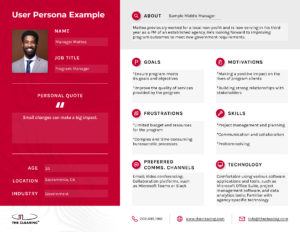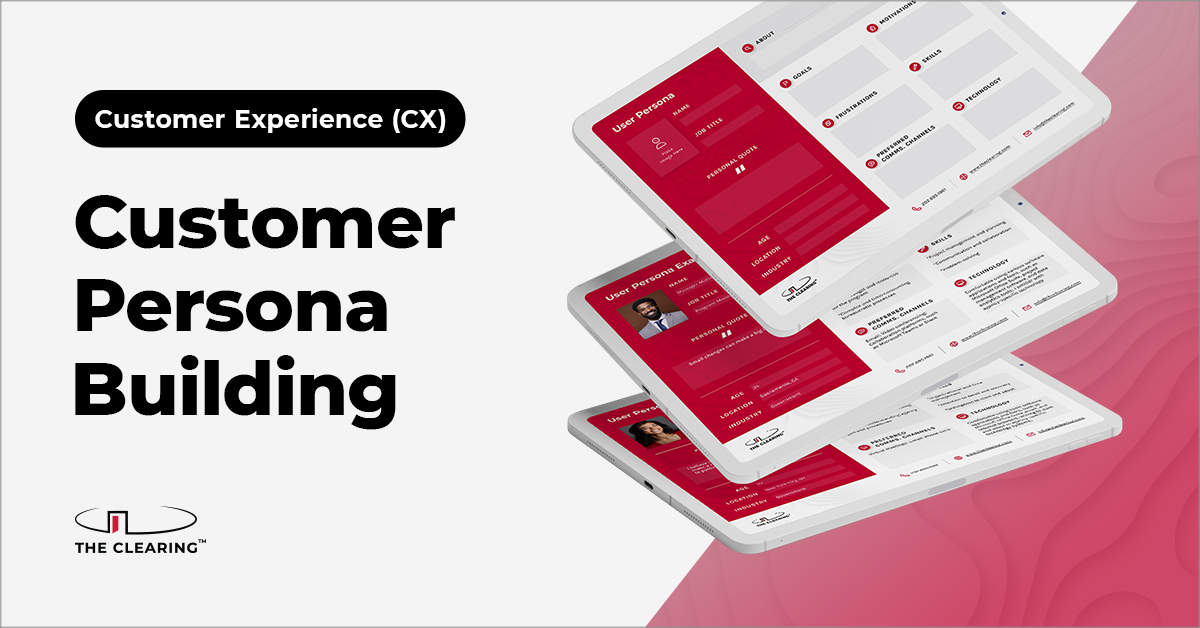Getting to know your customers has never been more important, and creating customer personas is a great place to start. Customer experience expert Robyn Klem has helped clients across industries create and use customer personas. Below, she explains what they are and how you can get started building personas of your own.
Customer Personas 101
A customer persona is a realistic representation of your customers or stakeholders. Think of it as a view into who the people interacting with your organization are. It’s important to note up front that customer personas don’t represent the nuance of every single person; they represent groups of customers with similar needs. And remember, your customers aren’t limited to the people who consume your product or interact with your organization. They can also be employees, vendors, or other groups whose experience impacts your organization’s success.
At a basic level, customer personas often include the following information:
- Demographics such as age (or an age range), where they live, industry they work in, etc.
- Profession or role in their organization
- Goals, motivations, and frustrations
- What types of skills they have and their understanding of technology
- How they prefer to be communicated with (i.e., email, text, phone, etc.)
Once you’ve built your persona(s), you use it as a tool to better understand the larger customer journey and make necessary and targeted changes to support customer needs. These learnings also allow you to make more informed organizational decisions to better equip your internal employees and stakeholders with key information needed to take action and enact change.
How We Create Customer Personas
Typically, you start with a template and fill it in with the relevant information for your customer and organization. I’m admittedly biased, but The Clearing’s customer persona template is a great resource for getting started. Let’s go through an example of creating a persona to better illustrate the process.
Step One: First, identify the challenge you are solving for or the opportunity you’d like to uncover. In our example, imagine you are a manager tasked with improving employee experience in your department after receiving unfavorable feedback in an employee survey. To start, let’s fill in our template to create personas representing departmental personnel. We will begin with the data available from the survey that each participant has agreed to share freely.
Step Two: After filling in demographic information, you may discover team members fall into generational buckets (i.e., Generation X; millennials; Gen Z, etc.) that impact their outlook on work. From there, particular statements about what motivates these groups may emerge: “I show up to work because I want to collect the paycheck”; “I show up to work because I love socialization with my peers;” or “I love the impact that I have.” Next, combine these motivators with other data to form a more complete picture. For example, Gen Z and Millennials may have no issue with new technology or communicating digitally, while Boomers may feel they’re being left behind. Generation X may feel stuck behind Boomers, losing hope that managerial positions will never open. As you can see, as you add information it becomes easier to identify the challenges driving employee experience scores.
Finally, put it all together in the template for the complete picture, like so:

How to Use Customer Personas
To state the obvious: in order to make your customer personas effective, you have to use them!
They don’t do any good sitting on the shelf. With that friendly reminder out of the way, here are some key things to remember to get the most out of your personas.
First and foremost, it’s important to remember they aid in discovering universal needs and desires, not individual ones. For example, while Rosa from accounting and Daryl from purchasing may differ on some specifics, their overall workplace desires and motivators put them in the same customer persona.
Second, use them to help connect the dots. Going back to our employee experience example, you may have heard about challenges in pockets: people saying the onboarding experience left them unprepared; that there aren’t enough training resources for an aspiring manager; or there aren’t enough healthy options in the cafeteria. Using your personas can help you and your fellow managers get up and out of your individual lanes and start to connect the employee experience dots across your organization.
Finally, these may be a sample set of your customers, but they do represent the views of real people. So, think about those people’s reactions to potential policy changes. Using your personas, consider how a change may affect one persona vs. another. For example, adding items to the cafeteria menu may result in a positive reaction across personas; while revamping management training options may only impact a specific group. In short, using personas can help you identify and make the most impactful decisions to benefit your customers.
Building out customer personas can seem daunting. Even with the best templates, choosing the right information is challenging. However, the payoff in knowing your customers more intimately is worth it. If you find yourself stuck on how to move forward with creating customer personas or using ones you already have, contact me at robyn.klem@theclearing.com – I’d love to discuss how we can help.


 The Clearing’s Employee Experience
Improvement model, adapted from Itam
& Ghosh, 2020, focuses on three objectives:
The Clearing’s Employee Experience
Improvement model, adapted from Itam
& Ghosh, 2020, focuses on three objectives: 


















